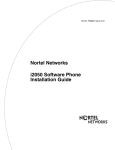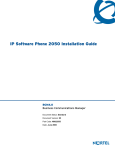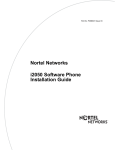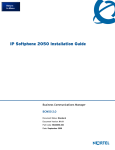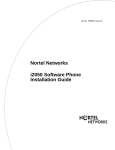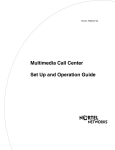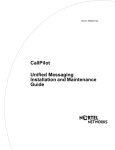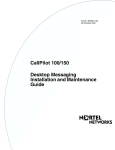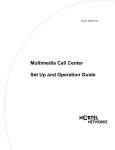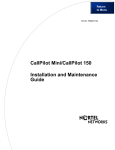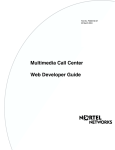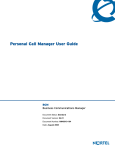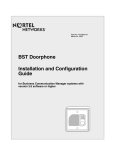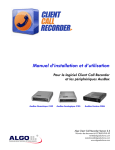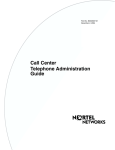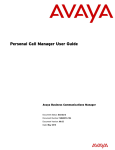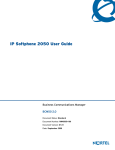Download Avaya i2050 Installation Guide
Transcript
i2050 Software Phone Installation Guide Part No. N0022555 01 08 April 2005 2 Copyright © Nortel Networks Limited 2005 All rights reserved. All rights reserved. 08 April 2005. The information in this document is subject to change without notice. The statements, configurations, technical data, and recommendations in this document are believed to be accurate and reliable, but are presented without express or implied warranty. Users must take full responsibility for their applications of any products specified in this document. The information in this document is proprietary to Nortel Networks NA Inc. Trademarks *Nortel, Nortel (Logo), the Globemark, and This is the way, This is Nortel (Design mark) are trademarks of Nortel Networks. *Microsoft, MS, MS-DOS, Windows, and Windows NT are registered trademarks of Microsoft Corporation. All other trademarks and registered trademarks are the property of their respective owners. N0022555 01 3 Contents Nortel Networks Software License Agreement . . . . . . . . . . . . . . . . . . . . . . . 7 Preface . . . . . . . . . . . . . . . . . . . . . . . . . . . . . . . . . . . . . . . . . . . . . . . . . . . . . . . 9 Symbols used in this guide . . . . . . . . . . . . . . . . . . . . . . . . . . . . . . . . . . . . . . . . . . . . . . 9 Acronyms . . . . . . . . . . . . . . . . . . . . . . . . . . . . . . . . . . . . . . . . . . . . . . . . . . . . . . . . . . . . 9 Related publications . . . . . . . . . . . . . . . . . . . . . . . . . . . . . . . . . . . . . . . . . . . . . . . . . . 10 How to get help . . . . . . . . . . . . . . . . . . . . . . . . . . . . . . . . . . . . . . . . . . . . . . . . . . . . . . 10 USA and Canada Authorized Distributors . . . . . . . . . . . . . . . . . . . . . . . . . . . . . . . 10 EMEA (Europe, Middle East, Africa) . . . . . . . . . . . . . . . . . . . . . . . . . . . . . . . . . . . 10 CALA (Caribbean & Latin America) . . . . . . . . . . . . . . . . . . . . . . . . . . . . . . . . . . . 11 APAC (Asia Pacific) . . . . . . . . . . . . . . . . . . . . . . . . . . . . . . . . . . . . . . . . . . . . . . . . 11 Chapter 1 Introduction . . . . . . . . . . . . . . . . . . . . . . . . . . . . . . . . . . . . . . . . . . . . . . . . . . 13 Chapter 2 Installing the i2050 Software Phone. . . . . . . . . . . . . . . . . . . . . . . . . . . . . . . 15 Hardware and software requirements . . . . . . . . . . . . . . . . . . . . . . . . . . . . . . . . . . . . . 15 Minimum PC requirements . . . . . . . . . . . . . . . . . . . . . . . . . . . . . . . . . . . . . . . . . . 15 Supported Operating Systems . . . . . . . . . . . . . . . . . . . . . . . . . . . . . . . . . . . . . . . 15 USB Audio Kit . . . . . . . . . . . . . . . . . . . . . . . . . . . . . . . . . . . . . . . . . . . . . . . . . . . . 16 Installing the USB Audio Headset . . . . . . . . . . . . . . . . . . . . . . . . . . . . . . . . . . . . . . . . 17 USB FAQ . . . . . . . . . . . . . . . . . . . . . . . . . . . . . . . . . . . . . . . . . . . . . . . . . . . . . . . . 17 Optional In-Use indicator (not provided with kit) . . . . . . . . . . . . . . . . . . . . . . . . . . 17 Installing the i2050 Software Phone . . . . . . . . . . . . . . . . . . . . . . . . . . . . . . . . . . . . . . 18 To install using the i2050 Software Phone CD . . . . . . . . . . . . . . . . . . . . . . . . . . . 18 To install using Business Communications Manager . . . . . . . . . . . . . . . . . . . . . . 18 Additional installation steps for Windows 2000 . . . . . . . . . . . . . . . . . . . . . . . . . . . 19 Communications Server configuration . . . . . . . . . . . . . . . . . . . . . . . . . . . . . . . . . . . . . 21 i2050 Configuration Utility . . . . . . . . . . . . . . . . . . . . . . . . . . . . . . . . . . . . . . . . . . . . . . 22 Communications Server . . . . . . . . . . . . . . . . . . . . . . . . . . . . . . . . . . . . . . . . . . . . 23 Select Sound Devices . . . . . . . . . . . . . . . . . . . . . . . . . . . . . . . . . . . . . . . . . . . . . 24 USB Headset Adapter . . . . . . . . . . . . . . . . . . . . . . . . . . . . . . . . . . . . . . . . . . . . . . 25 External Lamp Indication . . . . . . . . . . . . . . . . . . . . . . . . . . . . . . . . . . . . . . . . . . . 26 Server Type . . . . . . . . . . . . . . . . . . . . . . . . . . . . . . . . . . . . . . . . . . . . . . . . . . . . . . 28 QoS . . . . . . . . . . . . . . . . . . . . . . . . . . . . . . . . . . . . . . . . . . . . . . . . . . . . . . . . . . . . 29 Hardware ID . . . . . . . . . . . . . . . . . . . . . . . . . . . . . . . . . . . . . . . . . . . . . . . . . . . . . 30 Advanced Audio . . . . . . . . . . . . . . . . . . . . . . . . . . . . . . . . . . . . . . . . . . . . . . . . . . 31 Listener IP . . . . . . . . . . . . . . . . . . . . . . . . . . . . . . . . . . . . . . . . . . . . . . . . . . . . . . 32 i2050 Software Phone Installation Guide 4 Contents Trace . . . . . . . . . . . . . . . . . . . . . . . . . . . . . . . . . . . . . . . . . . . . . . . . . . . . . . . . . . 33 About . . . . . . . . . . . . . . . . . . . . . . . . . . . . . . . . . . . . . . . . . . . . . . . . . . . . . . . . . . . 34 Accessing the i2050 Software Phone help . . . . . . . . . . . . . . . . . . . . . . . . . . . . . . . . . 35 Registering the i2050 Software Phone on Business Communications Manager . . . . . 36 Troubleshooting . . . . . . . . . . . . . . . . . . . . . . . . . . . . . . . . . . . . . . . . . . . . . . . . . . . . . . 37 Chapter 3 i2050 Software Phone interfaces . . . . . . . . . . . . . . . . . . . . . . . . . . . . . . . . . 39 Primary User Interface . . . . . . . . . . . . . . . . . . . . . . . . . . . . . . . . . . . . . . . . . . . . . . . . . 40 System Tray Interface . . . . . . . . . . . . . . . . . . . . . . . . . . . . . . . . . . . . . . . . . . . . . . . . . 44 Local Directory Interface . . . . . . . . . . . . . . . . . . . . . . . . . . . . . . . . . . . . . . . . . . . . . . . 46 Chapter 4 Nortel i2050 Diagnostic Utility . . . . . . . . . . . . . . . . . . . . . . . . . . . . . . . . . . . 49 Starting the i2050 Diagnostic Utility . . . . . . . . . . . . . . . . . . . . . . . . . . . . . . . . . . . . . . . 49 Starting the i2050 Diagnostic Tool using the Start menu . . . . . . . . . . . . . . . . . . . 49 Starting the i2050 Diagnostic Tool using the command line . . . . . . . . . . . . . . . . . 50 Viewing the diagnostic information . . . . . . . . . . . . . . . . . . . . . . . . . . . . . . . . . . . . . . . 50 Audio connection data . . . . . . . . . . . . . . . . . . . . . . . . . . . . . . . . . . . . . . . . . . . . . . 50 Session data . . . . . . . . . . . . . . . . . . . . . . . . . . . . . . . . . . . . . . . . . . . . . . . . . . . . . 52 Current User data . . . . . . . . . . . . . . . . . . . . . . . . . . . . . . . . . . . . . . . . . . . . . . . . . 52 System Data (All Users) . . . . . . . . . . . . . . . . . . . . . . . . . . . . . . . . . . . . . . . . . . . . 53 Utility output . . . . . . . . . . . . . . . . . . . . . . . . . . . . . . . . . . . . . . . . . . . . . . . . . . . . . 54 Updating the diagnostic information . . . . . . . . . . . . . . . . . . . . . . . . . . . . . . . . . . . . . . 54 Updating the diagnostic information manually . . . . . . . . . . . . . . . . . . . . . . . . . . . 55 Configuring the i2050 Diagnostic Utility to automatically update the diagnostic information . . . . . . . . . . . . . . . . . . . . . . . . . . . . . . . . . . . . . . . . . . . . 55 Saving the current diagnostic information to a file . . . . . . . . . . . . . . . . . . . . . . . . . . . . 55 Printing the diagnostic information . . . . . . . . . . . . . . . . . . . . . . . . . . . . . . . . . . . . . . . 56 Changing the printer settings . . . . . . . . . . . . . . . . . . . . . . . . . . . . . . . . . . . . . . . . 56 Sending an email with the diagnostic information . . . . . . . . . . . . . . . . . . . . . . . . . . . . 56 Opening an existing diagnostic file . . . . . . . . . . . . . . . . . . . . . . . . . . . . . . . . . . . . . . . 56 Closing an existing diagnostic file . . . . . . . . . . . . . . . . . . . . . . . . . . . . . . . . . . . . . . . . 57 Displaying or hiding the Toolbar . . . . . . . . . . . . . . . . . . . . . . . . . . . . . . . . . . . . . . . . . . 57 Displaying or hiding the Status Bar . . . . . . . . . . . . . . . . . . . . . . . . . . . . . . . . . . . . . . . 57 Accessing the i2050 Diagnostic Utility help . . . . . . . . . . . . . . . . . . . . . . . . . . . . . . . . . 57 Accessing additional information . . . . . . . . . . . . . . . . . . . . . . . . . . . . . . . . . . . . . . . . . 58 Exiting the i2050 Diagnostic Utility . . . . . . . . . . . . . . . . . . . . . . . . . . . . . . . . . . . . . . . 58 N0022555 01 5 Figures Figure 1 Primary Interface with retracted trays . . . . . . . . . . . . . . . . . . . . . . . . . . . . 40 Figure 2 Local Directory Quick Access . . . . . . . . . . . . . . . . . . . . . . . . . . . . . . . . . 40 Figure 3 Retracted Tray . . . . . . . . . . . . . . . . . . . . . . . . . . . . . . . . . . . . . . . . . . . . . 41 Figure 4 Number Pad Tray . . . . . . . . . . . . . . . . . . . . . . . . . . . . . . . . . . . . . . . . . . . 41 Figure 5 Lines Tray . . . . . . . . . . . . . . . . . . . . . . . . . . . . . . . . . . . . . . . . . . . . . . . . . 42 Figure 6 Combo Tray . . . . . . . . . . . . . . . . . . . . . . . . . . . . . . . . . . . . . . . . . . . . . . . 42 Figure 7 Local Directory Quick Access Tray . . . . . . . . . . . . . . . . . . . . . . . . . . . . . . 43 Figure 8 System Tray Interface . . . . . . . . . . . . . . . . . . . . . . . . . . . . . . . . . . . . . . . . 44 Figure 9 System Tray Interface - Local Directory Quick Access . . . . . . . . . . . . . . . 45 Figure 10 Directory interface . . . . . . . . . . . . . . . . . . . . . . . . . . . . . . . . . . . . . . . . . . 47 Figure 11 Directory interface - make a call . . . . . . . . . . . . . . . . . . . . . . . . . . . . . . . . 48 Figure 12 Directory interface - linking to an external directory . . . . . . . . . . . . . . . . . 48 i2050 Software Phone Installation Guide 6 N0022555 01 7 Nortel Networks Software License Agreement READ THE TERMS AND CONDITIONS OF THIS AGREEMENT CAREFULLY BEFORE PROCEEDING TO INSTALL AND USE THIS COMPUTER PROGRAM AND ANY ACCOMPANYING USER DOCUMENTATION. This Nortel Networks Software License Agreement (“License Agreement”) accompanies a software product and related documentation (collectively, “Software”) that are owned or licensed by Nortel Networks Corporation on behalf of itself and its subsidiaries (collectively, “Nortel”). 1 Grant of License: Subject to the terms of this License Agreement and the payment of the applicable license fees, Nortel hereby grants to you, and you accept, a non-exclusive, non-transferable right to: (a) install one copy of the Software in a single location on a hard disk or other storage device, and to execute such copy solely for your internal use; and (b) store another copy of the Software in a single location on a hard disk or other storage device solely for backup purposes. Nortel and its suppliers reserve any rights not expressly granted to you herein, including without limitation any rights in trademarks included with the Software, any rights in copies of the Software, and any other intellectual property rights in the Software. 2 Ownership of Software and Copies: You acknowledge and agree that (a) the Software is a proprietary product of Nortel and/or its suppliers protected under United States copyright law, patent law, trademark law and/or related international treaty provisions; and (b) elements of the software, including without limitation the structure, algorithms, and programming techniques are valuable trade secrets of Nortel and its suppliers. 3 Restrictions: Neither concurrent use of the Software, nor installation of the Software through a local area network, is permitted without separate authorization from Nortel, and the payment by you of any other license fees. You shall not reverse engineer, decompile, disassemble, or otherwise attempt to discover the source code of the Software except to the extend such prohibition is contrary to law. You shall not modify, adapt, translate or create derivative works based on the Software except as necessary for you to operate the Software on a computer of your selection. You shall not rent, lease, sublicense, or otherwise distribute the Software or derivative works thereof, but you may transfer all your rights in the Software to another person or entity, provided that you transfer this License Agreement and all copies of the Software in your possession. 4 Termination: This license is effective upon your clicking the “ACCEPT” button, and shall continue until terminated as hereinafter set forth. If you don’t ACCEPT these terms, clicking the CANCEL button will signify your rejection of this Agreement and the rights granted herein. If you choose to cancel this Agreement you may return this product to the place of purchase to receive a refund of any license fees paid. Nortel may terminate this license automatically and without notice to you, and require you to return or destroy the Software and all copies thereof, if you are in breach of any term hereof. In any event, Article 2 – Ownership of Software and Copies, Article 3 – Restrictions, Article 5 - Disclaimer or Warranty, and Article 6 – No Liability for Consequential Damages, shall survive termination. i2050 Software Phone Installation Guide 8 Nortel Networks Software License Agreement 5 DISCLAIMER OF WARRANTY: THE SOFTWARE IS PROVIDED ON AN “AS IS” BASIS. NORTEL DISCLAIMS ALL REPRESENTATIONS, WARRANTIES AND CONDITIONS RELATING TO THE SOFTWARE, INCLUDING BUT NOT LIMITED TO, IMPLIED WARRANTIES OF MERCHANTABILITY, FITNESS FOR A PARTICULAR PURPOSE AND NON-INFRINGEMENT. NORTEL DOES NOT WARRANT, GUARANTEE, OR MAKE ANY REPRESENTATIONS REGARDING THE USE, OR THE RESULTS OF THE USE, OF THE SOFTWARE IN TERMS OF CORRECTNESS, ACCURACY, RELIABILITY, CURRENTNESS, OR OTHERWISE. 6 NO LIABILITY FOR CONSEQUENTIAL DAMAGES: NEITHER NORTEL NOR ANY OF ITS AGENTS OR SUPPLIERS SHALL BE LIABLE FOR ANY INDIRECT, CONSEQUENTIAL, INCIDENTAL OR EXEMPLARY DAMAGES, OR LOST DATA, OR LOST PROFITS, ARISING FROM THE SOFTWARE OR THIS LICENSE AGREEMENT, EVEN IF NORTEL OR SUCH AGENT OR SUPPLIER HAS BEEN ADVISED OF THE POSSIBILITY OF SUCH DAMAGES OR LOSSES AND WHETHER ANY SUCH DAMAGE ARISES OUT OF CONTRACT (INCLUDING FUNDAMENTAL BREACH) TORT (INCLUDING NEGLIGENCE) OR OTHERWISE. NORTEL’S ENTIRE LIABILITY FOR ANY CLAIM OR LOSS, DAMAGE OR EXPENSE FROM ANY CAUSE WHATSOEVER, WHETHER ARISING IN CONTRACT (ETC.) SHALL IN NO EVENT EXCEED THE PRICE PAID BY YOU UNDER THIS LICENSE AGREEMENT. In some jurisdictions you may have additional rights in which case some of the above may not apply to you. 7 Governing Law: This License Agreement is governed by the laws of Ontario and the federal laws of Canada applicable therein. The United Nations convention on Contracts for the International Sale of Goods, is expressly excluded. You agree that the Software shall not be shipped, transferred, or exported into any country or used in any manner prohibited by the United States Export Administration Act, or any other export laws, restrictions or regulations. 8 Notice to United States Government End Users: You acknowledge that any Software furnished under this License Agreement is commercial computer software developed at private expense and is provided with RESTRICTED RIGHTS. Any use modification, reproduction, display, release, duplication or disclosure of this commercial computer software by the United States Government or its agencies is subject to the terms and conditions and restrictions of the License Agreement in accordance with the United States Federal Regulations at 48 C.F.R. Section 12.212 and Subsection 227.7202-3 or applicable subsequent regulations. 9 General: Should any term of this License Agreement be declared void or unenforceable, such term shall be deemed severable from the remaining terms but shall in no way otherwise affect the validity or enforceability of this License Agreement. This License Agreement represents the entire agreement between Nortel and you concerning the Software, and supersedes all prior understandings and agreements relating to the Software, whether oral or written. The failure of Nortel to enforce any of its rights granted hereunder or to take action against you in the event that you breach any term hereunder, shall not be deemed to be a waiver by Nortel as to subsequent enforcement of rights or subsequent actions in the event of future breaches by you. N0022555 01 9 Preface This guide describes how to install the Nortel i2050 Software Phone. Review this guide before installing, upgrading, or modifying the i2050 Software Phone. This guide also contains information regarding the Nortel USB Audio Kit. This guide is intended for the person installing the i2050 Software Phone and assumes that the Communications Server is installed and initialized. Symbols used in this guide This guide uses these symbols to draw your attention to important information: Caution: Caution Symbol Alerts you to conditions where you can damage the equipment. Warning: Warning Symbol Alerts you to conditions where you can cause the system to fail or work improperly. Note: Note/Tip symbol Alerts you to important information. Acronyms This guide uses the following acronyms: ACD Automatic Call Distribution DHCP Dynamic Host Control Protocol DNS Domain Name Service IP Internet Protocol LAN Local Area Network NIC Network Interface Card QoS Quality of Service TPS Terminal Proxy Server USB Universal Serial Bus WAN Wide Area Network i2050 Software Phone Installation Guide 10 Preface Related publications The following documents provide additional information about configuring and using IP telephones: • • • Programming Operations Guide IP Telephony Configuration Guide Software Keycode Installation Guide After you have successfully installed the i2050 Software Phone, you can access the i2050 Software Phone help system. This help system describes how to use and configure the i2050 Software Phone. How to get help If you do not see an appropriate number in this list, go to www.nortel.com/cs. USA and Canada Authorized Distributors Technical Support - GNTS/GNPS Telephone: 1-800-4NORTEL (1-800-466-7835) If you already have a PIN Code, you can enter Express Routing Code (ERC) 196#. If you do not yet have a PIN Code, or for general questions and first line support, you can enter ERC 338#. Website: http://www.nortel.com/cs Presales Support (CSAN) Telephone: 1-800-4NORTEL (1-800-466-7835) Use Express Routing Code (ERC) 1063# EMEA (Europe, Middle East, Africa) Technical Support - CTAS Telephone: *European Free phone 00800 800 89009 N0022555 01 Preface 11 European Alternative: United Kingdom +44 (0)870-907-9009 Africa +27-11-808-4000 Israel 800-945-9779 Calls are not free from all countries in Europe, Middle East, or Africa. Fax: 44-191-555-7980 E-mail: [email protected] CALA (Caribbean & Latin America) Technical Support - CTAS Telephone: 1-954-858-7777 E-mail: [email protected] APAC (Asia Pacific) Service Business Centre & Pre-Sales Help Desk: +61-2-8870-5511 (Sydney) Technical Support - GNTS Telephone: +612 8870 8800 Fax: +612 8870 5569 E-mail: [email protected] Australia 1-800-NORTEL (1-800-667-835) China 010-6510-7770 India 011-5154-2210 Indonesia 0018-036-1004 Japan 0120-332-533 Malaysia 1800-805-380 i2050 Software Phone Installation Guide 12 Preface New Zealand 0800-449-716 Philippines 1800-1611-0063 Singapore 800-616-2004 South Korea 0079-8611-2001 Taiwan 0800-810-500 Thailand 001-800-611-3007 Service Business Centre & Pre-Sales Help Desk +61-2-8870-5511 N0022555 01 13 Chapter 1 Introduction The i2050 Software Phone is a Voice over IP application that enables users to communicate over the LAN and WAN from their computers. It combines the rich set of classic telephony services of Nortel IP communications servers along with computer-resident directory capabilities. The i2050 Software Phone presents the following benefits: • • • • • • • • • • offers the rich set of telephony services of Nortel IP communications servers such as Meridian 1, CSE 1000, Business Communications Manager, Centrex, and SL-100. offers the “universality” of a Windows-based application encapsulates the operation of the i2004, providing all i2004 functionality in a familiar interface wrapper. As per the i2004, the i2050 Software Phone provides: — Quality of Service (QoS) and authentication — automatic detection of call server location using DHCP — features and services are provided by the network (such as call features, calling line identification, and voice mail) reduces the set of wires required to the desktop by eliminating the need for separate computer and telephone wires presents an intuitive, flexible interface including: — slide-out trays that provide access to frequently used features and services — retracted trays that provide a smaller interface with full operational capabilities for a single line — viewable line status — ten item lists for quick dial and call log access from both the main and system tray interface — customizable interface and directories — multilingual interface — programmable macro functions for programming lengthy dialing patterns — hotkeys that map the computer keyboard to application buttons can be operated from the Windows system tray, allowing the user to take and place calls without interrupting other work includes a directory application that provides “one-click” direct dialing, access to a variety of directory types, quick dial lists, and incoming and outgoing call logs interfaces with TAPI applications such as Outlook and ACT! provides immediate answers to user questions through online help provides USB Audio Kit that has a controlled high quality audio environment. This adapter provides: — provides predictable, absolute audio levels — uses standard Windows drivers i2050 Software Phone Installation Guide 14 Chapter 1 Introduction • • — requires no additional software or drivers — provides in-use lamp connector provides user selectable ringing device to alert the user to incoming calls through speakers when the headset is not being worn supports G.723, G.729 and G.711 codecs for a operation at a variety of network connection speeds The intuitiveness of the i2050 Software Phone interface is based on its similarity and compatibility with the ergonomics of the i2004 Internet Telephone and Windows-based applications. Training investment with the i2004 and network applications presented using the i2004 are directly portable to i2050 Software Phone use. Moreover, the i2050 Software Phone allows users to customize the interface to their own preferences for: • • • • volume of speaker and microphone type of “receiver and speaker” (handset, headset, or hands-free communication) language of interface ringer device The i2050 Software Phone presents clearly identified windows to allow users to: • • • • manage one or more communications in progress access local or remote corporate directories track and manage records of incoming and outgoing calls access network resident services provided by the call server, such as voice mail N0022555 01 15 Chapter 2 Installing the i2050 Software Phone This section describes how to install the Nortel i2050 Software Phone and the Nortel USB Audio Kit. Hardware and software requirements Minimum PC requirements • • • • • • Pentium® Pro 200 MHz 128 MB memory (for Windows 2000) 64 MB memory (for Windows 98) 55 MB free hard-drive space (all languages) USB port Monitor settings: 16 bit High Color; 800x600 resolution or higher Supported Operating Systems • • • • • • Windows® 2000 Professional Windows® 2000 Professional Service Pack 1 Windows® 2000 Professional Service Pack 2 Windows® 98 Windows® 98 Second Edition Windows XP (Home and Professional version) Note: You must have administrator privileges to install the i2050 Software Phone on Windows 2000. Windows 2000 Power Users can install the i2050 Software Phone if they are granted rights to install with elevated privileges by a Windows 2000 administrator. For information on how to assign elevated privileges to Power Users for installation, refer to your Windows 2000 documentation. Pentium is a registered trademark of Intel Corporation. Windows is a registered trademark of Microsoft Corporation. i2050 Software Phone Installation Guide 16 Chapter 2 Installing the i2050 Software Phone USB Audio Kit Operation of the i2050 Software Phone requires the use of the Nortel USB Audio Kit. The USB Audio Kit provides a high quality predictable audio interface that is highly optimized for telephony applications. The USB Audio kit allows the i2050 Software Phone to have an absolute and predictable loss and level plan implementation, which is necessary to meet TIA-810, FCC part 68 and its international equivalents as well as the ADA requirements for the hearing impaired. With the USB Audio kit, the i2050 can achieve performance rivaling or surpassing that of hardware telephones. The USB Audio Kit is fully-compliant with version 1.1 of the USB Device Specification and Windows Plug & Play specifications. It is fully compatible with the suspend and resume functions for effective use in battery operated laptops. It is functional on Windows 2000 Professional, Windows 98, Windows 98 Second Edition, Windows Millennium and Windows XP. No drivers or software are required for installation. In the box • • • • • USB Headset Adapter Installation Guide (English and French) USB cord Telephony grade mon-aural headset Lower cordset with quick disconnect Connectors • • • RJ-9 headset/handset jack or mini jack (depending on model) Accessory jack for “in-use” lamp (not on all models) USB device jack Specifications • • • • • • • • Native Audio format: 16 bit linear 8 KHz over USB, limited to 8 bit PCM logarithmic coding in hardware OS Compatibility: Windows 98, Windows 98SE, Windows 2000, Windows ME, Windows XP Power Source: USB power provided from computer Enumeration: Enumerates as USB Composite Device and USB Audio Device Channels: Mandatory control channel for enumeration, Bi-directional isochronous channel for audio Electret Microphone Bias: 3 V Maximum SPL Protection: Limited in headset In-Use Lamp Connector: Isolated contact closure - polarity insensitive N0022555 01 Chapter 2 Installing the i2050 Software Phone 17 Installing the USB Audio Headset 1 If you have a two-piece headset cord, connect the coiled lower cord to the headset cord with the Quick Disconnect connector. Ensure the Quick Disconnect is securely fastened. If you have a one-piece headset cord, go to the next step. 2 Connect the headset cord to the RJ9 jack, or mini jack, on the adaptor. 3 Connect the USB cable to the headset adaptor and to one of the USB jacks on the back of your PC or USB hub. 4 The first time the headset adapter is plugged in, there is a delay while the Windows operating system configures the device and locates appropriate driver software. During the installation you can be prompted to supply the original Windows CD ROM so that the Windows operating system can locate drivers. 5 After you have installed the USB headset adapter, you must use the i2050 Software Phone Configuration Utility to select ‘USB Audio Device’. USB FAQ • My computer doesn't have USB, can I use an add-on USB card? The computer must have a USB connector. The USB Headset has not been tested on USB add on or upgrade cards. Performance or operation is not guaranteed of these cards. • I don't have enough USB ports available, can I use a USB hub? The USB Headset has been tested successfully behind a variety of USB hubs. It is not practical to test on all of a but no issues have been uncovered on the ones that have been tested. For best results, use a powered hubs. Optional In-Use indicator (not provided with kit) A 2.5mm output jack is provided next to the USB connector for activation of a visual in-use indicator such as the 1127P Desktop Visual Alerter from Algo Communication Products Ltd. (604) 454-3790 / [email protected] or equivalent. Note: Not all models of the USB Headset Adapter have the In-Use Indicator output jack. i2050 Software Phone Installation Guide 18 Chapter 2 Installing the i2050 Software Phone Installing the i2050 Software Phone Note: If you have previously installed a version of the i2050 Software Phone, you must uninstall the old version (through Add/Remove Programs) before installing this version. Note: Install the Nortel USB Audio Kit before installing the i2050 Software Phone. By doing this, you are presented with the option of using the USB Audio Device during installation of the i2050 Software Phone. There are two methods you can use to install the Software Phone. The installation method you use depends on the type of Communications Server you have. • • On a Business Communications Manager system, you download the installation wizard from the Business Communications Manager system, and run the wizard from your computer. On all other Communications Servers, you run the installation wizard from the i2050 Software Phone CD. To install using the i2050 Software Phone CD 1 Exit any programs that are running. 2 Disable any anti-virus programs that are running. 3 Insert the i2050 Software Phone CD into the CD-ROM drive of your computer. If the install wizard starts, go to step 6. If the install wizard does not start, go to step 4. 4 Double-click the My Computer icon, and then double-click the CD icon. 5 Double-click the Setup icon. 6 Follow the instructions on the display to complete the installation. 7 Run the i2050 Software Phone Configuration Tool to assign a server address and to configure audio peripherals. You can access the i2050 Software Phone from the Start menu at Start>Programs>Nortel Network>i2050 Software Phone. You can access the i2050 Software Phone Configuration Tool from the Windows Control Panel. To install using Business Communications Manager 1 Exit any Windows programs that are running. 2 Start a browser session and connect to the BCM50 web page. The BCM50 Login dialog box appears. 3 Enter your user name and password and click the OK button. The Welcome to BCM50 page appears. N0022555 01 Chapter 2 Installing the i2050 Software Phone 4 Click the User Applications link. The User Applications page appears. 5 Click the i2050 Software Phone link. The i2050 Software Phone download page appears. 6 Click the Download i2050 Software Phone link. The File Download dialog box appears. 7 Click the Save button and save the application to where you want to install it from. 8 After the application downloads, double-click it to launch the installation, and follow the instructions in the installation wizard. 19 You can access the i2050 Software Phone from the Start menu at Start>Programs>Nortel Networks>i2050 Software Phone. You can access the i2050 Software Phone Configuration Tool from the Windows Control Panel. Note: The installation files for the i2050 Software Phone are not deleted by the installation wizard. These files are stored in a folder named C:\Program Files\Nortel Networks\ClientInstall\i2050 Software Phone. You can delete the installation files as they are not needed by the i2050 Software Phone. Additional installation steps for Windows 2000 If you are installing the i2050 Software Phone on a computer using Windows 2000, you must: • • install the Windows QoS Packet Scheduler install the Nortel i2050 QoS Service The Windows QoS Packet Scheduler and the Nortel i2050 QoS Server enable 802.1p Quality of Service (QoS) on the computer. i2050 Software Phone Installation Guide 20 Chapter 2 Installing the i2050 Software Phone Installing the Windows QoS Packet Scheduler Note: You must have administrator privileges to install the QoS Packet Scheduler. To install the QoS Packet Scheduler: 1 In the Windows Control Panel, click Network and Dialup Connections. 2 Right-click the Local Area Connection for the device to be used, and click Properties. 3 Click Install. 4 On the Select Network Component Type screen, click Service, and then click Add. 5 On the Select Network Service screen, click QoS Packet Scheduler, and then click OK. You may require the Windows 2000 CD-ROM if the program can not find required files on your computer. Installing the Nortel i2050 QoS Service Note: Administrator privileges are required to install the Nortel i2050 QoS Service. If you have administrator privileges, the Nortel i2050 QoS Service is installed as part of the i2050 Software Phone installation. If you do not have administrator privileges, then an administrator must install the Nortel i2050 QoS Service for you, using a separate installation. The administrator must install the Nortel i2050 QoS Service after both the Windows QoS Packet Scheduler and the i2050 Software Phone are installed. Installing the Nortel i2050 QoS Service using the i2050 Software Phone CD 1 Exit any programs that are running. 2 Disable any anti-virus programs that are running. 3 Insert the i2050 Software Phone CD into the CD-ROM drive of your computer. If the install wizard starts, exit from the install wizard. 4 Use Windows Explorer to navigate to the QoS directory on the CD. 5 Double-click on the Setup icon in this directory. 6 Follow the instructions on the display to complete the installation. The Nortel i2050 QoS Service is configured to start automatically as a Windows service, so no further configuration is required for it. Installing the Nortel i2050 QoS Service using the Business Communications Manager 1 Exit any programs that are running. N0022555 01 Chapter 2 Installing the i2050 Software Phone 21 2 Disable any anti-virus programs that are running. 3 Launch your web browser. 4 In the URL address field, type the Business Communications Manager IP address, including the port number 6800. For example: HTTP://10.10.10.1:6800 Note: You must include HTTP:// with the address and port number to access Unified Manager when you are using Internet Explorer as your browser. 5 On the Unified Manager front page, click the Install Clients button. 6 Click the i2050 Software Phone link. 7 Click the Download Nortel Networks i2050 QoS Service button. A file download window appears. 8 Select Save this program to disk, and click the OK button. The SaveAs dialog box appears. 9 Choose a location to which to save this file, and click the Save button. The file begins downloading. 10 When the file is finished downloading, click the Close button. 11 Double-click on the i2050QoSService.exe file. 12 Follow the instructions on the display to complete the installation. The Nortel i2050 QoS Service is configured to start automatically as a Windows service, so no further configuration is required for it. Communications Server configuration After you have finished installing the i2050 Software Phone, you must configure the Communications Server to recognize and accept calls to and from the i2050 Software Phone. For information about how to configure your Communications Server, refer to the documentation that came with your Communications Server. i2050 Software Phone Installation Guide 22 Chapter 2 Installing the i2050 Software Phone i2050 Configuration Utility You configure the i2050 Software Phone using the configuration utility. To start the configuration utility using the Control Panel: 1 Click the Start button, and then click Settings. 2 Click Control Panel. 3 Double-click the i2050 Software Phone icon. To start the configuration utility using the Start menu: 1 Click the Start button, and click Programs. 2 Click Nortel Networks, and click i2050 Software Phone. 3 Click Configuration Tool. The configuration utility has tabs for • • • • • Communications Server Select Sound Devices USB Headset Adapter Server Type Additional tabs for system administrators N0022555 01 Chapter 2 Installing the i2050 Software Phone 23 Communications Server If your site uses DHCP: 1 Select the Obtain server address automatically option. Using DHCP is the default method of locating the Communications Server. If DHCP is used, no further configuration is required. Note: To use DHCP, you need a DHCP server with communications server IP address values programmed as per the i2004. If you are not using DHCP: 1 Select the Use the following server address information option. 2 Enter the name of the communications server, and then enter or select the port number. Or Enter the IP address of the communications server, and then enter or select the port number. If you do not know the communications server name or IP address and port number, ask your communications server administrator. Note: Using DHCP may not be appropriate for mobile users. These users commonly want to connect to their office communications server rather than the local office server. i2050 Software Phone Installation Guide 24 Chapter 2 Installing the i2050 Software Phone Select Sound Devices Table 1 Select Sound Devices Attribute Description Headset Microphone Enables you to select the microphone used for making calls. Select USB Audio Device. Headset Speaker Allows you to select the speaker used for making calls. Select USB Audio Device. Ringing Speaker Allows you to select a different speaker as a ringing device. If you select the computer speakers rather than on the headset, you can hear the phone ringing when you remove your headset. Audio Quality Allows you to adjust the internal buffering on the computer, enabling you to compensate for computer performance. If the audio is choppy or broken, move the slider toward Higher Quality. I use a modem to Select this option if you are using a low-speed connection. connect to the When you select this option, the i2050 Software Phone reports to the communications server that network G729 and G723 are the supported codecs. The communications server can select G711 later depending on its programming. When you clear this option, the i2050 Software Phone reports that it supports G711, G723, and G729A/G729AB. Not all servers support all codecs. G711 requires high bandwidth; G729 requires medium bandwidth; G723 requires low bandwidth. Apply to all users Users with administrator privileges (as determined by Windows) can apply selected audio settings to all users on this computer. Note: You can access also the Select Sound Device tab from i2050 Software Phone interface by clicking Configure Audio on the System menu or the File menu. N0022555 01 Chapter 2 Installing the i2050 Software Phone 25 USB Headset Adapter Use this screen to configure your USB Headset Adapter. Note: You must select the Headset Type to ensure optimal headset performance. Table 2 USB Headset Adapter Attribute Description Version Shows the version of the USB Headset Adapter. Note: If the USB Headset Adapter is not recognized or has a version number lower than 2.0, the other features in this table are grayed out and unavailable. Headset Type Select the type of headset that you have connected to the USB Headset Adapter. Due to differences in headset construction, you may not get optimal audio performance when using a headset that does not appear on the list. For optimal performance, always use one of the headsets that appears on the Headset Type drop list. Use backlight Select this check box to enable the backlight for the USB Headset Adapter buttons. Clear this check box to disable the backlight for the USB Headset Adapter buttons. Note: When you enable the backlight, you can use the state of the backlight to quickly determine if the i2050 Software Phone is running. When the backlight is on, the i2050 Software Phone is running. When the backlight is off, the i2050 Software Phone is not running. Configure Smart Functions Click this button to set the options that are available when you press the Smart Functions button on the USB Headset Adapter. For more information about the Smart Functions button, refer to the i2050 Software Phone Help. i2050 Software Phone Installation Guide 26 Chapter 2 Installing the i2050 Software Phone External Lamp Indication Use this screen to configure your optional external lamp. Note: The External Lamp is an optional component. It normally is not included with the USB Headset Adapter, and must be ordered separately. The external lamp also is known as an "In-Use Indicator" lamp. Table 3 External Lamp Indication Attribute Description Manual Override Select one of the available cadences to enable the Manual Override feature. For a description of the available cadences, refer to Table 4 on page 27. When Manual Override is enabled, you can manually turn on the external lamp using the i2050 Smart Functions button on the USB Headset Adapter. For more information about the i2050 Smart Functions button, refer to the i2050 Software Phone Help. Select None to disable the Manual Override feature. Headset Disconnect Select one of the available cadences if you want the external lamp to indicate when the headset is disconnected from the USB Headset Adapter. For a description of the available cadences, refer to Table 4 on page 27. Select None if you do not want the external lamp to indicate when the headset is disconnected. N0022555 01 Chapter 2 Installing the i2050 Software Phone 27 Table 3 External Lamp Indication (Continued) Attribute Description Active Call Select one of the available cadences if you want the external lamp to indicate when there is an active call on the i2050 Software Phone. For a description of the available cadences, refer to Table 4 on page 27. If the USB Headset Adapter is selected as the Ringing Speaker, the external lamp also indicates when there is a call ringing on the i2050 Software Phone. For information about setting the ringing device, refer to “Select Sound Devices” on page 24. Select None if you do not want the external lamp to indicate when there is an active call. Note: If you select a cadence for Active Call, the external lamp also turns on or flashes when another application uses the audio channel for the USB Headset Adapter. Message Waiting Select one of the available cadences if you want the external lamp to indicate when the i2050 Software Phone message waiting light is on. For a description of the available cadences, refer to Table 4 on page 27. The i2050 Software Phone message waiting light normally indicates when there is a message waiting. However, most systems also turn on or flash the message waiting light when the i2050 Software Phone is ringing. Select None if you do not want the external lamp to indicate when the message waiting light is on. If more than one External Lamp Indication option is enabled and active, the external lamp shows the cadence of the option with highest precedence. The precedence of the External Lamp Indication options from highest to lowest is: Manual Override, Headset Disconnect, Active Call, and then Message Waiting. For example, if there is a message waiting and an active call, the cadence for Active Call is used for the external lamp. Table 4 External Lamp Cadences Cadence Description On The external lamp is on-solid. Flash The external lamp cycles at the following rate: 0.5 seconds on; 0.5 seconds off. Flicker The external lamp cycles at the following rate: 1.625 seconds on; 0.375 seconds off. Blink The external lamp cycles at the following rate: 0.5 seconds on; 1.5 seconds off. i2050 Software Phone Installation Guide 28 Chapter 2 Installing the i2050 Software Phone Server Type To select your server type: 1 Select the option that matches the communications server you are using. For example, select BCM if you are using a Business Communications Manager system. 2 ACD agents also must select the Enable Symposium option. N0022555 01 Chapter 2 Installing the i2050 Software Phone 29 QoS Use this screen to enable Quality of Service (QoS) support on the i2050 Software Phone. Table 5 Quality of Service (QoS) Attribute Description On Select this option to turn 802.1 QoS on. When you select this option and the QoS Service is installed and running. The i2050 Software Phone adds 802.1q to the i2050 Software Phone packets. It also assigns 802.1p as per the Communications Server definition (default 6). Off Select this option to turn 802.1 QoS off. When you select this option, the i2050 Software Phone does not add 802.1q to the i2050 Software Phone packets, regardless of whether the QoS Server is present. Automatic detection Select this option if you want the i2050 Software Phone to determine if the 802.1 QoS is used. When you select this option, the i2050 Software Phone attempts to connect with 802.1q added to the packets. If the attempt is successful, then the i2050 Software Phone uses 802.1q for the call. If the attempt fails (there is a timeout after approximately 1 second), the i2050 Software Phone attempts to connect again without adding 802.1q to the packets. This is the default option. Apply to all users Users with administrator privileges (as determined by Windows) can apply the QoS settings to all users on this computer. i2050 Software Phone Installation Guide 30 Chapter 2 Installing the i2050 Software Phone Hardware ID Note: This screen is intended for expert users only. Table 6 Hardware ID Attribute Description Hardware ID Do not change the information in the first or last box in the Hardware ID field. The middle box contains the MAC address for the Ethernet card installed in your computer. The i2050 Software Phone uses the MAC address of the computer as its hardware ID. You may have to change this value if there is more than one Ethernet card in the PC or if the PC is using an extranet client that hides the true MAC address. For example, Nortel Contivity Extranet Switch uses a single MAC address for all clients. This can potentially cause connection issues with your communications server. Auto-Create Changes the MAC address that appears in the middle Hardware ID box. If your computer has more than one Ethernet card (and, therefore, more than one MAC address), click the Auto-Create button to cycle through the set of MAC addresses on your computer. Firmware Version Shows the software version of the i2050 Software Phone. N0022555 01 Chapter 2 Installing the i2050 Software Phone 31 Advanced Audio Note: This screen is intended for expert users only. You can use this screen to override the communications server defined values. Note: Changing the values on this screen should be considered a last resort if audio quality issues are encountered. Table 7 Advanced Audio Attribute Description Use Communication Server values The i2050 Software Phone uses the values assigned by the communications server. This is the normal mode of operation. Override Communication Server Values In very rare cases where audio quality is adversely affected by network performance for a few users, these values can achieve a workable balance of quality. i2050 Software Phone Installation Guide 32 Chapter 2 Installing the i2050 Software Phone Listener IP Note: This screen is intended for expert users only. This screen identifies the IP addresses and ports where the i2050 Software Phone is listening for UNIStim traffic. You can use this screen to override the port assignments when there is a conflicting application on the computer. Table 8 Advanced Audio Attribute Description Use all addresses The i2050 Software Phone listens to the IP addresses on all of the network interface cards on the computer for UNIStim traffic. This is the normal mode of operation. Port This value can require adjustment if another application on the computer is using the same port. The two applications can co-exist by moving the port or IP address to which the i2050 Software Phone is listening. Use specific address Using a specific address can be useful in cases where there is more than one Ethernet card, and an application conflict exists. N0022555 01 Chapter 2 Installing the i2050 Software Phone 33 Trace Note: This screen is intended for Nortel personnel only. This screen can be used to record UNIStim traffic. Note: For normal operation, the Enable option must be cleared. This disables the Trace feature. i2050 Software Phone Installation Guide 34 Chapter 2 Installing the i2050 Software Phone About This screen identifies the version of the i2050 Configuration Utility. This always matches the version of the i2050 Software Phone application. N0022555 01 Chapter 2 Installing the i2050 Software Phone 35 Accessing the i2050 Software Phone help After you have successfully installed the i2050 Software Phone, you can access the i2050 Software Phone help system. This help system provides detailed information about how to use and configure the i2050 Software Phone. To access the i2050 Software Phone help from the Primary interface (Enhanced): 1 Start the i2050 Software Phone. 2 On the System menu, click Help. 3 Click Contents. The i2050 Software Phone help window appears. To access the i2050 Software Phone help from the Secondary interface (Standard): 1 Start the i2050 Software Phone. 2 On the Help menu, click Contents. i2050 Software Phone Installation Guide 36 Chapter 2 Installing the i2050 Software Phone Registering the i2050 Software Phone on Business Communications Manager If you are using a Business Communications Manager as your communications server, the first time you start the i2050 Software Phone, you must register with the Business Communications Manager system. To register your i2050 Software Phone on a Business Communications Manager system: 1 Start the i2050 Software Phone. 2 If a password prompt appears on the i2050 Software Phone display, enter the registration password and press the OK soft key. If you do not know the registration password, contact your system administrator. 3 If a DN prompt appears on the i2050 Software Phone display, enter the DN you want assigned to this telephone, and press the OK soft key. After the registration is complete, you do not need to go through the registration steps described above, unless you deregister the terminal. If the i2050 Software Phone cannot register, or cannot find the communications server, refer to the IP Telephony Configuration Guide for more information about registering IP telephones. N0022555 01 Chapter 2 Installing the i2050 Software Phone 37 Troubleshooting Application fails to install Symptom: During installation the following error message appears: • Error 1931: The Windows Installer service cannot update the system file <filename>. Description: You are trying to install i2050 Software Phone on an outdated version of the operating system. Action: To fix the problem, you can upgrade your operating system. Check the Hardware and Software Requirements section of this document for the information on supported operating system releases. i2050 Software Phone Installation Guide 38 Chapter 2 Installing the i2050 Software Phone N0022555 01 39 Chapter 3 i2050 Software Phone interfaces This chapter describes the following i2050 Software Phone interfaces: • • • Primary User Interface, which provides access to features and line appearances System Tray Interface, which provides operation of the i2050 Software Phone from the Windows system tray Directory Interface, which offers access to internal and external databases (directory, personal address book, call logbook, quick dial lists) i2050 Software Phone Installation Guide 40 Chapter 3 i2050 Software Phone interfaces Primary User Interface The i2050 Software Phone Primary User Interface provides call control and access to other network services. The display area and application buttons are mapped directly from the i2004 Internet Telephone. Therefore, knowledge of one interface is directly portable to the other, reducing training costs. Figure 1 Primary Interface with retracted trays System Menu Message Waiting Minimize Exit Display area Interactive keys Mute Copy Volume control Show Lines Answer (Answer call/Make call) Quit Navigation keys Release Hold Trays Macros Directory Information/Help/About Inbox Outbox Quick Dials Redial List Services Switch Right See Figure 2 Figure 2 Local Directory Quick Access Switch Left See Figure 1 N0022555 01 Callers Local List Directory Chapter 3 i2050 Software Phone interfaces 41 The i2050's Enhanced Skin presents a small user interface that can be expanded by selecting various trays. — — — — — Retracted Tray Number Pad Tray Lines Tray Combo Tray Local Directory Quick Access Trays Figure 3 Retracted Tray • The default presentation is with the operational trays retracted. In this mode, the user can operate most features available from the i2004. Calls can be answered or made by pressing the green off-hook button. In this mode, the call server selects the line to answer or engage. The user also can hang-up, hold, retrieve from hold, mute, adjust volume, and access network services, such as voice mail. Figure 4 Number Pad Tray • Provides a graphic keypad to dial numbers on with a mouse. In all tray selections, numbers also can be dialed by using the computer keyboard. Number Pad i2050 Software Phone Installation Guide 42 Chapter 3 i2050 Software Phone interfaces Figure 5 Lines Tray • Shows up to six lines or feature keys provisioned for the telephone by the communications server. The status of each line is illustrated by a graphic icon (idle, ringing, connected, and so on). The line is labeled based on its call manager provisioning information. • Note: The line labels are specified in system programming by the system administrator. Line status icons Up to 6 lines Line labels from system programming Figure 6 Combo Tray • Combines the Line Tray and the Number Pad tray at the expense of the removal of the line state icons. Number Pad N0022555 01 Line labels from system programming Chapter 3 i2050 Software Phone interfaces 43 Figure 7 Local Directory Quick Access Tray • The Local Directory maintains lists of quick dials, redials, and callers. Ten of the items in these lists can be viewed and dialed directly from the Primary User Interface using Quick Access Trays. Name lists stored in local directory Make call - select line Make call - default line Quick Dials Redials List Callers Local List Directory Within the Primary User Interface, the computer keyboard provides hotkeys for one-press access to common features: • • • • • • • answer (Enter) release (F12) hold (F5) softkeys/interactive keys (F1-F4) alphabetic keys map to numbers as per i2004 dialpad mapping arrow keys map to navigation keys Alt-V paste/inserts data to the interface (For example, you can copy a phone number from Outlook, and paste it into the i2050 Software Phone interface.) i2050 Software Phone Installation Guide 44 Chapter 3 i2050 Software Phone interfaces System Tray Interface Many of the i2050 Software Phone features are available from the System Tray Interface. This interface enables you to operate the i2050 Software Phone without interrupting your workflow. For example, you can answer an incoming call from the system tray without launching the Primary User Interface. Figure 8 System Tray Interface Open Primary Interface (also double-click system tray icon) Launch Local Directory Play Macros Local Directory Lists Make Call (with dialog for entering number) Call Operations Programmed Lines (selectable) Line state icons Windows System Tray Lines labels i2050 icon (image changes with call state) Easy access to the Local Directory, Quick Dial, Redail, and Caller lists is provided by fly-out menus. N0022555 01 Chapter 3 i2050 Software Phone interfaces 45 Figure 9 System Tray Interface - Local Directory Quick Access Local Directory Lists Quick Dial List System Tray i2050 icon i2050 Software Phone Installation Guide 46 Chapter 3 i2050 Software Phone interfaces Local Directory Interface The i2050 Software Phone Directory Interface allows the user to maintain a personal directory for placing calls. The directory can be stored with the i2050 Software Phone itself (by default in a local file named Directory.mdb), or linked to external directories. Linking to LDAP, Outlook, Windows Address Book (WAB), and ACT! directory types is supported. Users can create, modify, and delete entries in the local directory, and can copy entries from external directories, the redial list and the caller lists into the local directory (select an entry, right-click and select "Add to Local Directory …"). Directory lists can be filtered in simple or complex ways to show, for example, people whose last name starts with “B” and who work for "Nortel". Ten items from each of the Quick Dial list, Caller list ad Redial list also viewable from the Primary User Interface and the System Tray Interface. The Quick Dial list is a shortcut to entries stored elsewhere (in the local directory or in an external directory). Callers list and Redial list are stored as lists within the directory storage file of the i2050 Software Phone. Some communications servers do not provide caller identification to the i2050 Software Phone. N0022555 01 Chapter 3 i2050 Software Phone interfaces 47 Figure 10 Directory interface New Edit Delete Search Filtered List Call Call Logs (Redials and Callers Lists) Integrated External Directories (LDAP, Outlook, Windows Address Book (WAB), ACT!) Quick Dial List Local / Personal Directory Calls can be made by selecting a contact entry, and then: • right-clicking and selecting which of the contact numbers to call. or • pressing the call function at the top of the directory window. i2050 Software Phone Installation Guide 48 Chapter 3 i2050 Software Phone interfaces Figure 11 Directory interface - make a call Make a call Figure 12 Directory interface - linking to an external directory (1) Right click on the shortcut bar N0022555 01 (2) Select Insert Directory … 49 Chapter 4 Nortel i2050 Diagnostic Utility The Nortel i2050 Diagnostic Utility is intended for use by groups that provide support for the Nortel i2050 Software Phone. This utility provides diagnostic information about: • • the i2050 configuration the current, or last, session and call You can display this diagnostic information on the i2050 Diagnostic Utility display, or you can save the information in a file. The files created by the i2050 Diagnostic Utility can be viewed using any web browser (for example, Internet Explorer), or can be E-mailed to a support group for analysis. Note: The Nortel i2050 Diagnostic Utility is intended for use by groups that provide support for the Nortel i2050 Software Phone. Starting the i2050 Diagnostic Utility If you start the i2050 Diagnostic Utility when the i2050 Software Phone is operating, the i2050 Diagnostic Utility displays information regarding the current session and call. If you start the i2050 Diagnostic Utility when the i2050 Software Phone is not operating, the i2050 Diagnostic Utility displays information about the last session and call. You must run the i2050 Diagnostic Utility in the same user context as the i2050 Software Phone is run. For example, if you want to obtain diagnostics regarding Sam, then Sam needs to run both the i2050 Software Phone and the i2050 Diagnostic Utility. If Sam runs the i2050 Software Phone and later an administrator logs on and runs the i2050 Diagnostic Utility, the diagnostics obtained are for the administrator, not for Sam. Note: When you make changes to the i2050 Software Phone using the i2050 Configuration Utility or the i2050 Software Phone parameters, the changes are reflected in i2050 Diagnostic Utility at the next refresh. Normally, the i2050 Software Phone does not pick up the values until the i2050 Software Phone has been stopped and re-started. A few settings are read on a per call basis, but you cannot rely on this. You can start the i2050 Diagnostic Utility using the Start menu or the command line. Starting the i2050 Diagnostic Tool using the Start menu 1 Click the Start button, and click Programs. 2 Click Nortel Networks, and click i2050 Software Phone. i2050 Software Phone Installation Guide 50 Chapter 4 Nortel i2050 Diagnostic Utility 3 Click i2050 Diagnostic Utility. Starting the i2050 Diagnostic Tool using the command line To start the i2050 Diagnostic Utility using a command line, you must know MS-DOS commands. If you do not know MS-DOS commands, refer to the documentation that came with your computer. Note: If you have downloaded a new version of the i2050 Diagnostic Utility since installing the i2050 Software Phone, you must use the command line to start the i2050 Diagnostic Utility. To start the i2050 Diagnostic Utility using a command line: 1 Start an MS-DOS session. 2 Move to the directory where the i2050 Diagnostic Utility is located. If you do not know the directory where it is located, use the Windows Find command to locate the i2050Diag.exe file. 3 Type i2050Diag and press Enter. The i2050 Diagnostic Utility starts. Viewing the diagnostic information The diagnostic information provided by the i2050 Diagnostic Utility is described in the following four sections. Note: If a source is shown, the source indicates where you can view the value and modify it, if possible. • If you can view the value from the i2050 Configuration Utility, the i2050 Configuration Utility tab appears in bold, and the field within that tab appears in italics. • If you can view the value from the i2050 Software Phone interface, i2050-> appears in bold, and the menu and field appear in italics. Audio connection data The audio connection data information applies to the current user of the i2050 Diagnostic Utility. For audio to be received and transmitted, an RTP stream must be: • Open (refer to Audio Started, Receive Stream Closed, Transmit Stream Closed) • Started (refer to Audio Started and Audio Stopped) • Connected to a transducer (refer to Receive Stream Connected, Transmit Stream Connected and Streams Disconnected) N0022555 01 Chapter 4 Nortel i2050 Diagnostic Utility • • 51 Not muted (refer to Mute Status and Current User Data's Headset Speaker) Receiving and transmitting data (refer to Receive Stream and Transmit Stream) Table 9 Audio connection data Data Description Stream Volume Volume of the audio stream indicated in percentage. Alerting Volume Volume of the alerting tone indicated in percentage. Audio Started Time the last (or current) audio connection started. A currently active audio stream is indicated by the comment Active. If there is no currently active audio stream, this is indicated by the comment Last Connection. Receive Stream Time the last (or current) audio receive stream connection started. A currently connected audio Connected stream is indicated by the comment Connected. If there is no currently connected receive stream, this is indicated by the comment Last Connection. Transmit Stream Connected Time the last (or current) audio transmit stream connection started. A currently connected audio stream is indicated by the comment Connected. If there is no currently connected transmit stream, this is indicated by the comment Last Connection. Receive Stream Number of packets and bytes of audio received during the last (or current) connection. The time indicates the last time this was updated. Updates occur every 1000 packets. Transmit Stream Number of packets and bytes of audio transmitted during the last (or current) connection. The time indicates the last time this was updated. Updates occur every 1000 packets. Streams Disconnected Last time the audio streams were disconnected. Receive Stream Last time the receive audio stream was closed. Closed Transmit Stream Closed Last time the receive audio stream was closed. Audio Stopped Time the audio was stopped. Mute Status Indication by the color red appearing on the mute button; this indication is controlled by the Terminal Proxy Server (TPS). The TPS uses different messages to control the state of the mute button, and the actual mute condition of the audio. These two values can get out of sync. The Mute status value here indicates the mute status of the audio stream, as opposed to the button status. A second mute control exists, and is shown in the Current User Data section under Headset Microphone. Source: Mute status of the audio stream Current 802.1p (Requires NIC Support) Indication that the i2050 Software Phone is sending 802.1p (on) or not (off) if the NIC (Network Interface Card) supports 802.1p. Jitter Jitter parameters used for the last (or current) call. The time of the last jitter update is indicated. If the computer is overriding the Communications Server assigned jitter values (Advanced Audio Override Communications Server values), this is indicated in the System Data section under Local Jitter Settings. Source 1: Advanced Audio Use Communications Server values Source 2: Advanced Audio Override Communications Server values Open RX Stream Parameters for the last (or current) receive audio stream. The time indicates when the stream was opened. Codec selection, frames per packet, RTP/RTCP ports, RTP/RTCP DiffServ and 802.1p values are reported here. If there is a currently open receive stream, this is indicated by the comment Active. i2050 Software Phone Installation Guide 52 Chapter 4 Nortel i2050 Diagnostic Utility Table 9 Audio connection data Data Description Open Tx Stream Parameters for the last (or current) transmit audio stream. The time indicates when the stream was opened. Codec selection, frames per packet, RTP/RTCP ports, RTP/RTCP DiffServ and 802.1p values are reported here. If there is a currently open transmit stream, this is indicated by the comment Active. Session data The session data indicates when a session is started, stopped, and in some cases, a detailed reason why the application is stopped. The session data information applies to the current user of the i2050 Diagnostic Utility. Table 10 Session data Data Description Session Start The current connection is indicated by the IP address of the current TPS (Terminal Proxy Server). The time indicates when the session was connected. The previous 6 connection starts also are indicated by time stamps. • Assign Terminal ID is a UNISTIM message that the i2050 Diagnostic Utility uses to indicate the start of the session. Session End The last six or seven connection end times are indicated in this column. • Server Switch indicates the session was ended when the TPS instructed the i2050 Software Phone to move to another server. In some systems, the i2050 Software Phone instructed to move to another server for load balancing reasons. • internalShutdown indicates the i2050 Software Phone reset on its own. This can be due to the user exiting the application. • Watchdog Expired indicates a loss of connectivity with the communications server. • SoftReset and HardReset indicate the communications server has instructed the i2050 Software Phone to reset. Reason The reason in more detail for the i2050 Software Phone shutdown, such as Watchdog Expired. Current User data The Current User data overrides the System data. When a value is present in this table and replicated in the System Data table, the value in use is the value for the current user of i2050 Diagnostic Utility. When a value is unassigned here, the value in use is the value that appears in the System data table. N0022555 01 Chapter 4 Nortel i2050 Diagnostic Utility 53 The current user data information applies to the current user of the i2050 Diagnostic Utility. Table 11 Current User data Data Description Current Skin The i2050 Software Phone skin selected by the user. Source: i2050->Select Skin Language Selected The language selected by the user. Source: i2050->Select Language Use 802.1p The indication of whether QoS 802.1p is being used. Source: QoS 802.1p I use a modem to • Slow connection indicates the check box is selected. connect • Fast Connection indicates the check box is cleared. Source: Select Sound Devices I use a modem to connect to the network PC Audio Buffer The setting for the PC Audio Buffer (Audio Quality Slider). Source: Select Sound Devices Audio Quality slider Headset Microphone The setting for the Headset microphone. The comment "Muted" indicates the device is muted by Windows. Source 1: Select Sound Devices Headset Microphone Source 2: i2050-> Configure Audio -> Headset Microphone Headset Speaker The setting for the Headset speaker. Source 2: Select Sound Devices Headset Speaker Source 2: i2050-> Configure Audio -> Headset Speaker Ringing Speaker The setting for the Ringer volume. Source 3: Select Sound Devices Ringing Speaker Source 2: i2050-> Configure Audio -> Ringing Speaker System Data (All Users) The System Data information applies to all users on the computer. Many individual items can be overridden by a user. To determine a value in use, look first in the Current User Data table. If no value is found, look in the System Data table. Table 12 System data (Sheet 1 of 2) Data Description Software Version i2050 Software Phone version. Source 1: About Version Source 2: Hardware ID Firmware Version Source 3: i2050->About Hardware ID Value saved on the Communications Server can be viewed on the i2050 Software Phone Services menu. Source 1: Hardware ID Hardware ID Source 2: Services - Set Info - HWID Note: On CSE 1000 and Meridian 1 switches, the value displayed on the Service menu and the value displayed in the i2050 Diagnostic Utility are different. The first two bytes (31-38) saved with the i2050 Software Phone are displayed in the Services menu as their ascii values (18). i2050 Software Phone Installation Guide 54 Chapter 4 Nortel i2050 Diagnostic Utility Table 12 System data (Sheet 2 of 2) Data Description Local Address Source: Listener IP Server IP address and port of the server. If DHCP is being used, it is indicated as such. Server Type Source: Server Type Trace Source: Trace Current Skin Source: i2050->Select Skin Language Selected Source: i2050->Select Language Local Jitter Settings Item present if the computer overrides the Communications Server assigned jitter values. If this item is not present, the application is using Communication Server values. Source: Advanced Audio Override Communications Server values Use 802.1p Source: QoS 802.1p I use a modem to connect Slow connection indicates the check box is checked. Fast Connection indicates the check box is cleared. Source: Select Sound Devices I use a modem to connect to the network PC Audio Buffer Computer Audio Buffer (Audio Quality Slider) Source: Select Sound Devices Audio Quality slider Headset Microphone Value typically reports "No Value Assigned" unless a user with administrator privileges checks the Apply to all users check box on the Select Sound Devices tab. Source: Select Sound Devices Headset Microphone Headset Speaker Value typically reports "No Value Assigned" unless a user with administrator privileges checks the Apply to all users check box on the Select Sound Devices tab. Source: Select Sound Devices Headset Speaker Ringing Speaker Value typically reports "No Value Assigned" unless a user with administrator privileges checks the Apply to all users check box on the Select Sound Devices tab. Source: Select Sound Devices Ringing Speaker Utility output This section contains the results saved from the ping and trace route dialog. Utility output only appears if the results are saved. Utility output is overwritten each time the utility dialog saves its data. Updating the diagnostic information The diagnostic information that appears on the i2050 Diagnostic Utility is the information that is current when you start the i2050 Diagnostic Utility. You can update the diagnostic information manually, or you can configure the i2050 Diagnostic Utility to update the information automatically. Note: The options for updating the diagnostic information are not available when you view information from a file. N0022555 01 Chapter 4 Nortel i2050 Diagnostic Utility 55 Updating the diagnostic information manually To update the diagnostic information to reflect any changes that occurred since you started the i2050 Diagnostic Utility: 1 On the View menu, click Refresh. Or Click the Refresh button on the Toolbar. The diagnostic information is updated to reflect the most current information. Configuring the i2050 Diagnostic Utility to automatically update the diagnostic information To configure the i2050 Diagnostic Utility to update automatically the diagnostic information, you must set the interval for Refresh, and turn on the Auto-Refresh option. 1 On the View menu, click Set Refresh Interval. 2 Enter the number of minutes that the i2050 Diagnostic Utility waits between updates of the diagnostic information. 3 Click the OK button 4 On the View menu, click Auto-Refresh. Or Click the Auto-Refresh button on the Toolbar. The i2050 Diagnostic Utility updates the diagnostic information at the frequency you specify for the Set Refresh Interval. Saving the current diagnostic information to a file You can save the diagnostic information you are viewing to a file. You can then view this file later using a web browser or the i2050 Diagnostic Utility, or you can send it to your i2050 Software Phone support personnel. To save the current diagnostic information to a file: 1 On the File menu, click Save as. Or Click the Save button on the Toolbar. 2 Move to the directory to which you want to save the diagnostic file. 3 Enter a file name, and click Save. i2050 Software Phone Installation Guide 56 Chapter 4 Nortel i2050 Diagnostic Utility Printing the diagnostic information You can print the diagnostic information you are viewing. To print the diagnostic information: 1 On the File menu, click Print. Or Click the Print button on the Toolbar. Changing the printer settings You can modify printer selection or change the printer setup. 1 On the File menu, click Print Setup. 2 Change the printer settings, and then click the OK button. Sending an email with the diagnostic information You send an email message that contains the diagnostic information you are viewing. 1 On the File menu, click Send. The diagnostic information you are viewing is saved to as an HTML file. A send email message window then opens with the HTML file as an attachment. 2 Enter the E-mail address of the person to whom you want to send the diagnostic information, and then send the message. Opening an existing diagnostic file You can use the i2050 Diagnostic Utility to view a diagnostic information file that you created earlier or that another user sent. Note: When you are viewing a existing diagnostic file, the Refresh options on the toolbar and in the View menu are disabled. To open an existing diagnostic file: 1 On the File menu, click Open. Or Click the Open button on the Toolbar. 2 Move to the folder where the diagnostic file is stored. 3 Click the file you want to open, and then click the Open button. N0022555 01 Chapter 4 Nortel i2050 Diagnostic Utility 57 Closing an existing diagnostic file When you are finished viewing a diagnostic file, you can close that file. Note: When you close the diagnostic file, the Refresh options on the toolbar and in the View menu are enabled. To close an existing diagnostic file: 1 On the File menu, click Close. Displaying or hiding the Toolbar The i2050 Diagnostic Utility Toolbar provides one-click access to several i2050 Diagnostic Utility options. To hide or display the Toolbar: 1 On the View menu, click Toolbar. When a check mark appears beside the Toolbar menu option, the Toolbar appears on the i2050 Diagnostic Utility display. Displaying or hiding the Status Bar The Status Bar displays information about the current status of the i2050 Diagnostic Utility. To hide or display the Status Bar: 1 On the View menu, click Status Bar. When a check mark appears beside the Status Bar menu option, the Status Bar appears on the i2050 Diagnostic Utility display. Accessing the i2050 Diagnostic Utility help To access the i2050 Diagnostic Utility help: 1 On the Help menu, click Documentation. i2050 Software Phone Installation Guide 58 Chapter 4 Nortel i2050 Diagnostic Utility Accessing additional information To access additional information about the i2050 Diagnostic Utility: 1 On the Help menu, click About. The About window appears. The About window displays information about the i2050 Diagnostic Utility, such as the version number. From this window, you also can access two Microsoft Windows diagnostic utilities by clicking the buttons on the window. These buttons are described in the following table. Table 13 Microsoft Windows Utilities Button Description System Info Click this button to launch the Microsoft Windows System Information utility. The Microsoft Windows System Information utility is a troubleshooting utility that provides computer information including: • System Summary (Operating System type and build, processor, memory, and so on) • Hardware Resources • Components (including USB, where the USB audio device appears if it is enumerated properly by the Operating System) • Software Environment • Internet Explorer information • Microsoft Applications You can save this information to a file that you can email back to the support group. The Tools menu item within System Information utility also provides access to other Microsoft trouble shooting utilities. Utilities Click this button to open a window with a server address of the current (or last) Terminal Proxy Server (TPS) address. From this window you can change the TPS IP address. This window also has buttons to ping and trace route the TPS IP address. The number of echoes the pings perform is controlled by the "Ping Count" field. The Use DNS field controls whether the ping and trace route resolve addresses to hostnames using DNS (this can cause the ping and trace route to run slower). The ping and trace route results are displayed in the encapsulated text window. These utilities can be used to verify network connectivity with the TPS, round trip times for ping, network nodes, and hops between the PC and the TPS address. You can save the output window to the diagnostic HTML file, which you can then E-mail to the support group. Exiting the i2050 Diagnostic Utility To exit from the i2050 Diagnostic Utility: 1 On the File menu, click Exit. N0022555 01


























































